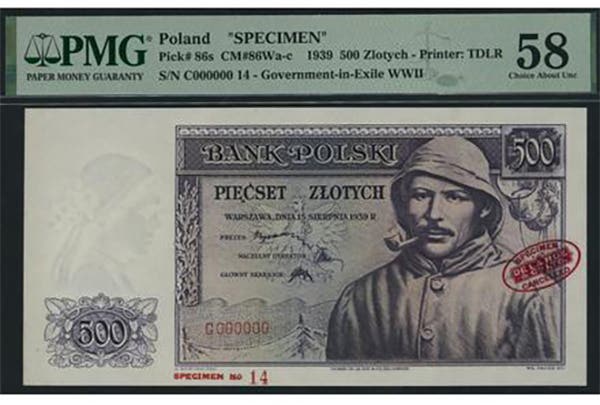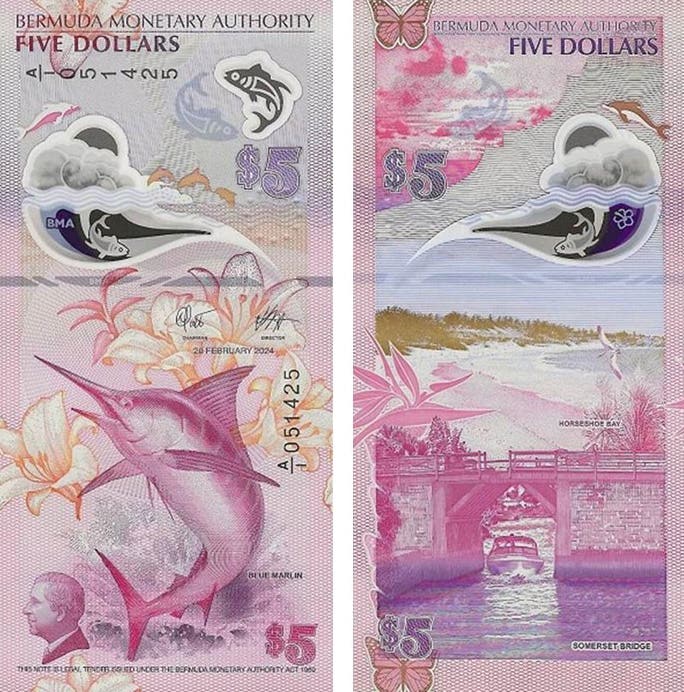Blockbuster Wyoming Discovery
by Peter Huntoon Heritage Auctions is offering the monster discovery note illustrated from The First National Bank of Guernsey, Wyoming, in their 2020 FUN sale. The First National Bank of…
by Peter Huntoon
Heritage Auctions is offering the monster discovery note illustrated from The First National Bank of Guernsey, Wyoming, in their 2020 FUN sale.
The First National Bank of Guernsey was organized April 10, 1900, chartered April 20, and liquidated May 1, 1901. It was the shortest-lived note-issuing bank in the state. The bank had no predecessor or successor.
During its short life of a year and a few days, the bankers received a total of 3,048 $5, $10 and $20 brown backs, to maintain a circulation of $25,000. The bank ranks as having received the fifth smallest number of notes for a Wyoming bank.
This amounted to 400 sheets of 5-5-5-5 and 362 sheets of 10-10-10-20s. These total $26,100 so $1,100 had been redeemed before the bank was liquidated proving that the notes were put into active circulation as indicated on their 1900 report of condition.
All 400 sheets, the total amount printed, of $5s were sent from the Comptroller’s office as the first shipment to the bank on Aug. 11, 1900. The 10-10-10-20 sheets followed staggered in shipments inclusive of Aug. 14, 1900 and May 4, 1901. The last of the 10-10-10-20s was sent three days after the bank was liquidated because the liquidation papers had not arrived in Washington yet.
There are two very interesting features on this discovery note, the coat-of-arms on its back and, of course, the banker’s signatures.
The coat-of-arms is not the state seal, rather it is a modified territorial seal. Wyoming was granted statehood in 1890. However, the timely adoption of a state seal by the legislature was delayed owing to a prank where a drawing of a nude woman was substituted for a more decorous seal that had come out of the legislative committee charged with creating it on its way to the governor’s office for his signature. The bruhaha that ensued caused the adoption of a state seal to be delayed for three years. You can read that tale in Huntoon (2008).
An engraving of the state seal by the Bureau of Engraving and Printing did not become available until 1896 so the modified territorial seal was used in its stead on all the Series of 1875 and early Series of 1882 state notes. The modification consisted of the addition of the 1890 statehood year inside the top of the shield.
The BEP never did make Series of 1875 backplates for Wyoming with the state seal despite the fact that that last bank to receive those notes did so through 1901.
The Series of 1882 brown backplates with the state seal were certified near the end of 1896; however, by then the BEP had a stockpile of preprinted 1882 backs with the modified territorial seal so they worked through those first.
The $5 Guernsey note was printed in 1900, revealing that they were still working down the stock of obsolete $5 backs. This came as a surprise to me because I thought the changeover to the state seal would have occurred much sooner. However, only three banks in Wyoming were issuing $5 brown backs so the demand for them was small. The other banks were Douglas (3556) and Cheyenne (2652).
The most striking thing on the note are the strong bank signatures. They are Henry G. Hay, president, and Harry G. Hay, cashier. Harry was the president’s son, whose formal name was Henry G. Hay, Jr. Their middle initial “G” stood for Gurley.
They also used Henry and Harry on their organization certificate, as well as on their report of condition that was listed in the 1900 annual report of the Comptroller of the Currency.
The similarities between their signatures are striking. It almost appears that both were applied by the father as an expedient when the sheets arrived. However, Mark Drengson located a copy of Henry G. Hay Jr.’s draft registration card and his signature on it matches well that found on the note.
Henry Hay became a prominent and wealthy banker in Cheyenne. He was born Oct. 31, 1847, and raised in Vincennes, Indiana, and graduated from the Eastman Commercial College at Poughkeepsie, N.Y., in 1866.
He went west to Readsville, Missouri, where he served as superintendent of a lead mine for four years, starting at the age of 19. From there he went to Cheyenne, Wyoming Territory, as a government surveyor, while also getting into the sheep business in a partnership with John Thomas on land nine miles south of Cheyenne. The sheep outfit was sold to Wyoming Senator Francis G. Warren in 1883.
About 1875, he also became a partner in Whipple and Hay, a large grocery enterprise that served as outfitter for the Black Hills and ranches. That business also was sold in 1883.
From 1883 to 1894, Whipple and Hay organized and operated the Laramie River Cattle Co. This along with his previous sheep operation were high-risk ventures that proved to be money sinks.
Relevant to this tale, Hay became a principal organizer of The Stock Growers National Bank of Cheyenne, which opened Dec. 19, 1881, first serving as cashier until 1894, then as president until 1903. The Stock Growers bank survived the panic of 1893 and eventually recovered during Hay’s tenure to become the largest bank in the region.
Hay also had a political life while in Cheyenne, wherein he was elected State Treasurer in 1894 and 1902.
Hay left the bank in 1903 at age 56 to become assistant treasurer of U. S. Steel Co. in New York City, where he worked under treasurer Richard Trimble. Trimble had solicited him for the position, having known and befriending him while both were running cattle in Wyoming before Hay’s banking days. Hay died Aug. 18, 1919, at 71, while still a resident of New York City.
Hay’s son, Henry G. Hay, Jr., was born on June 30, 1876. He became a lawyer and entered banking with his father in Cheyenne. Junior’s claim to fame in national banking, besides being involved in the Guernsey bank, was that he was a principal in the organization of The Wind River National Bank of Shoshoni and served as its first cashier in 1906. He went by his formal name in that endeavor. That bank was sold to The First National Bank of Shoshoni in 1908. Harry had left the bank by then and went east, eventually becoming president of the Gary State Bank in Indiana.
Harry had a son, Henry G. Hay III, born in 1900, who was too young to have been involved in any of this tale.
Guernsey was founded in 1900 by the Burlington Railroad, which was being built northwestward along the North Platte River and had entered Wyoming from Nebraska in 1900. It is obvious that Henry Hay saw an opportunity there and wanted to get in on the ground floor with a bank. A post office had just been established and the town was starting to take shape. Neither the town or bank flourished so the bank was folded a year later.
Within a few years, the town served as a shipping point for iron ore that was mined at the Sunrise mines at Hartville six miles to the north on a spur line. The area also looked favorable for farming but cattle ranching continued to dominate the agricultural sector.
The town of Guernsey was named for Charles. A. Guernsey, a cattle rancher who also founded the Wyoming Railway and Iron Company to exploit the iron deposits in the area.
The Guernsey breed of dairy cattle had nothing to do with Guernsey or the town. Rather, the breed originated on the Island of Guernsey, the northernmost island in the Channel Islands between England and France.
Guernsey is located halfway between Casper and Cheyenne astride the North Platte River, which flows toward the southeast there. The Oregon trail paralleled the southern bank of the river so today the major tourist attraction in Guernsey is deep wagon wheel ruts worn several feet into a resistant ledge of rock that caps a low bluff along the south bank of the river.
The emigrants had to climb over the bluff as they passed the future townsite in their Conestoga wagons drawn by oxen, mules and heavy draft horses. Some 400,000 migrants used the trail between the mid-1830s through late 1860s as they headed west to new lives.
Another attraction is Register Cliffs, now a state park. The cliffs are located southeast of town, also on the south side of the river where the immigrants carved their names or initials into sandstone outcrops. Historic Fort Laramie, an army outpost that protected the trail and later was involved in the Indian Wars, lies 13 miles to the southeast along the trail.
US 26 and the Burlington Northern Railroad now follow that route through eastern Wyoming, except both lie north of the river. The highway passes through the center of Guernsey. The town has a population of about 1,150 people.
Guernsey is situated in low rolling hills with the Great Plains stretching off to the east and the Laramie Mountain range on the horizon to the southwest.
A major facility located at Guernsey is Camp Guernsey, a military training center with operations in artillery, bombing, personnel and equipment airdrops, fixed-wing and helicopter aircraft, etc.
There now remain only three note-issuing banks out of 51 in Wyoming for which notes are unreported. They are The Cheyenne National Bank (3416), The First National Bank of Sundance (4343), and The Wind River National Bank of Shoshoni (8232), the latter being the bank that Henry G. Hay, Jr. helped organize.








